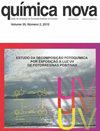利用硅模型评价天然水中农药残留、药物和代谢物的毒性
IF 0.7
4区 化学
Q4 CHEMISTRY, MULTIDISCIPLINARY
引用次数: 0
摘要
评估天然水体中农药残留、药物和代谢物毒性的计算机模型工作流程。我们必须不断地处理工业合成和制造的各种化合物的数量呈指数级增长的问题,如药物、杀虫剂、持久性有机污染物、防腐剂和个人卫生用品。这些化学物质中有许多具有生物活性,并通过特定机制与生物分子(如蛋白质)相互作用,从而导致不同的生物反应。由于许多化合物对环境和人类的固有风险,必须对其毒理学活性进行评估。为了评估分子的生物活性,可以使用三种类型的实验:体内(例如,动物试验);体外(如细胞组织培养);在计算机模拟中。体内和体外实验是耗时和昂贵的过程,除了引起伦理讨论和辩论。避免这些挫折的另一种选择是使用计算机模型。因此,科学界开始使用计算机模型作为一种可能的替代方法,开发了大量能够预测几种化合物毒理学特性的模型和策略。本文讨论了采用计算机模型来评估和预测天然水体中发现的污染物可能产生的影响的方法。本文章由计算机程序翻译,如有差异,请以英文原文为准。
UTILIZAÇÃO DE MODELOS IN SILICO PARA AVALIAÇÃO DA TOXICIDADE DE RESÍDUOS DE AGROTÓXICOS, FÁRMACOS E METABÓLITOS EM ÁGUAS NATURAIS
WORKFLOW OF IN SILICO MODELS TO EVALUATE THE TOXICITY OF PESTICIDE RESIDUES, DRUGS AND METABOLITES IN NATURAL WATERS. Constantly we have to deal with an exponential increase in the amount of different chemical compounds that industries synthesize and manufacture, such as drugs, pesticides, persistent organic pollutants, preservatives, and personal hygiene products. Many of these chemical substances are biologically active and interact with biomolecules, such as proteins, through specific mechanisms that lead to different biological responses. Due to the inherent risk of many compounds to the environment and to humans, their toxicological activities must be evaluated. In order to evaluate the biological activity of molecules, three types of experiments can be used: in vivo (e.g., animal tests); in vitro (e.g., cell tissue culture); and in silico simulations. In vivo and in vitro experiments are time-consuming and expensive processes, in addition to causing ethical discussions and debates. An alternative to avoid these setbacks is the use of in silico models. The scientific community thus begins to use in silico models as a possible alternative, developing a large number of models and strategies capable of predicting the toxicological properties of several chemical compounds. This review discusses methods that employ in silico models to assess and predict the possible effects of contaminants found in natural waters.
求助全文
通过发布文献求助,成功后即可免费获取论文全文。
去求助
来源期刊

Quimica Nova
化学-化学综合
CiteScore
1.60
自引率
12.50%
发文量
72
审稿时长
2-4 weeks
期刊介绍:
Química Nova publishes in portuguese, spanish and english, original research articles, revisions, technical notes and articles about education in chemistry. All the manuscripts submitted to QN are evaluated by, at least, two reviewers (from Brazil and abroad) of recognized expertise in the field of chemistry involved in the manuscript. The Editorial Council can be eventually asked to review manuscripts. Editors are responsible for the final edition of QN.
 求助内容:
求助内容: 应助结果提醒方式:
应助结果提醒方式:


